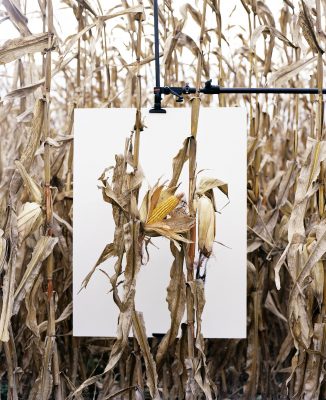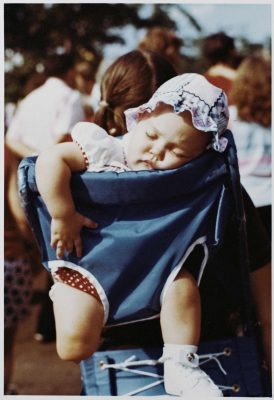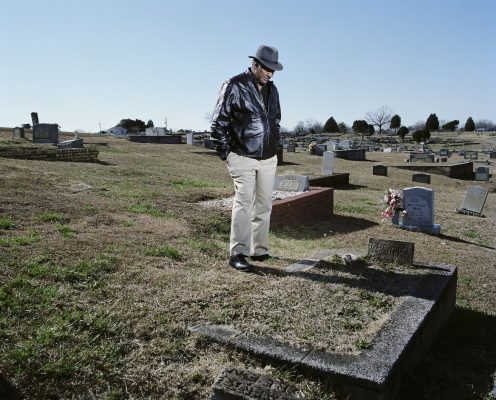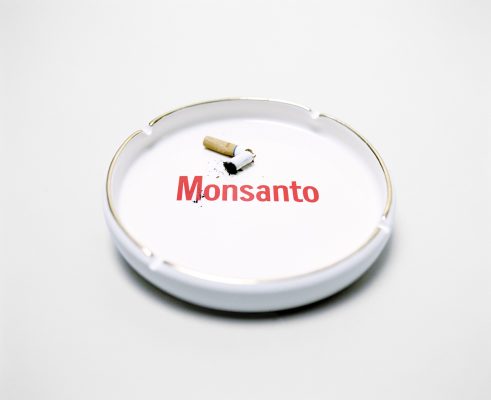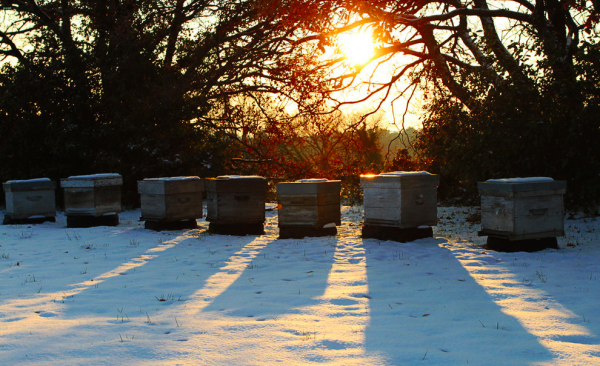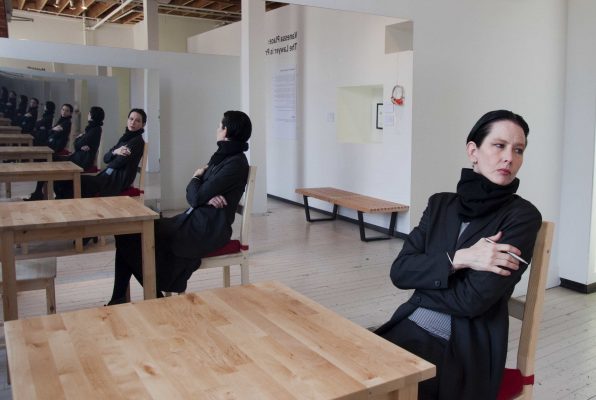I’ve often wondered how high finance has ended up so closely involved with the earnestly ethical practice of documentary photography. The Swiss asset manager Pictet Group sponsors Photo London fair, J.P. Morgan sponsors Paris Photo, and the Frankfurt stock exchange sponsors and names the Deustche Börse prize. Mathieu Asselin is the only nominee for the latter prize who has incorporated this contradiction into his exhibition, albeit in a small way. Placed among his photographs, on the wall at the Photographers’ Gallery in London, is a neatly framed electronic screen, ‘provided free of charge by the official Börse Frankfurt App’, showing in real time the stock price of Monsanto, the corporation which Asselin hopes to bring down.
Asselin is part of a wave of documentary artists using film and photography to powerful effect. His project, a book entitled Monsanto: A Photographic Investigation (Kettler Verlag, 2017), is a sprawling five year project tracing the long destructive history of the eponymous chemicals manufacturing and agroindustrial company.
The 43 year old French-Venezuelan photographer first made his name covering large scale disasters – a destructive tornado in the American Midwest, and the BP Gulf Oil Spill in Florida. For these projects Asselin expertly employed a common trope of disaster photography – portraits of victims amongst the wreckage. In the case of Monsanto there are plenty of victims, but tracking and photographing the wreckage left by the company is a more complicated task. How do you photograph economic structures, unseen illnesses, pollutants with effects that unfold over decades, a relentless public relations machine? In the face of this challenge Asselin evolved his methods. The resultant book is halfway between a beautifully designed report and an eclectic scrapbook. It tells the history of the company across four linked projects – ‘House of the Future’, ‘Agent Orange’, ‘Monsanto City’ and ‘The Contract’ – using carefully composed photographic landscapes, portraits and still lifes, corporate contracts, collages, adverts, videos (via QR code), maps, tables, letters, doodles, slogans and postcards.
As the pages turn, and this material piles up, Monsanto comes across as a kind of sprawling voracious monster, twisting and devouring the futures of millions of people in order to maintain its bloated profitability in the present. The company continued to manufacture lucrative toxic chemicals across the twentieth century, long after their dangers became clear. Running like a thread through the book are a series of muted portraits of people who have found themselves in the path of the company over the years. One such person is David Baker, a resident of Anniston, Alabama, pictured standing next to his brother’s grave: Trevor Baker died at the age of 16 from brain cancer. Monsanto manufactured the chemical PCB (used in everything from refrigerators to newsprint) in Anniston from 1929 to 1971, dumping tons of the raw carcinogen into a local river, releasing it into the atmosphere and burying thousands more tons in a nearby landfill. There’s evidence that from the thirties onwards Monsanto knew how dangerous PCBs were after testing the chemical on rats. In 1969 an internal committee convened by the company to examine PCBs concluded that they would become a ‘global environmental contaminant’. Despite this knowledge they continued to release the chemical into the waterways of Anniston, which Asselin photographs in black and white, overlaid with a queasy red wash – a roughly executed and eerily effective method he uses elsewhere in the book to signal hidden chemical contamination.
Woven in among portraits of residents like Baker who’ve stuck around in Anniston, desperately petitioning Monsanto and the authorities for compensation, are photographs of the crumbling, abandoned houses and demolished ruins left behind by everyone who has died or fled the area. Elsewhere in the book a newspaper clipping from the late 1970s describes evacuation efforts in the small town of Sturgeon, Missouri after a Monsanto tanker carrying a ‘wood preservative’ derailed and cracked open, spilling its cargo on the town’s streets. Residents weren’t told at the time that the substance involved in the spill contained dioxin, one of the most toxic chemicals known to man. They later took on Monsanto in court – a case which was, at the time, the longest running in American legal history. They won, receiving punitive damages, but many only got a single token dollar in injury compensation.
Alongside these blighted landscapes, Asselin includes an old advert for Monsanto’s ‘House of the Future’, an attraction built by the company in Disneyland to promote its plastic wonder materials. Scanning a QR code takes you to the ten minute promotional video from 1957, showing the viewer around a curvy hi-tech bungalow on stilts. A perfect fifties family enter the house to look around, sampling the retractable refrigerated ‘cool zones’, the smell-on-demand system (pine, sea air) and the convenient all-plastic kitchen accessories.
The video, included along with a faded company postcard of Anniston, is a reminder of how much the continuation of Monsanto’s violence against people relied (and relies) on their command and control of information, from suppressed scientific data to expensive advertising stunts. PCBs and the plastics they enabled were presented as wonder materials, an essential element of technological modernity, and their disastrous shortcomings were overlooked for long enough to make some money. Thus as Asselin charts the victims and the polluted landscapes, he also charts the flows of information that made such damage possible. When photographing the site of the chemical spill in Sturgeon, he unexpectedly includes a photograph of the microfilm machine at the State Historical Society of Missouri that he used to access the newspaper archive. Flourishes like these draw attention to his own informational labour, how evidence of the damage caused by a company like Monsanto can lay dormant, disparate and individually deniable unless skilfully assembled and presented, as it is here.
The most acutely troubling section of the book deals with Agent Orange, a defoliant manufactured by Monsanto and sprayed by the U.S. over Vietnam from 1962 to 1971, intended to destroy thick jungle cover and starve its victims by destroying their ability to grow food. Dioxin, one of the toxic chemicals in Agent Orange, is bio-accumulative, meaning it travels up the food chain through meat, eggs, dairy and breast milk, causing diseases and birth defects over many generations. Over 500,000 babies were born with birth defects in Vietnam as a result, and 2 million people suffer from cancer or other diseases linked to chemical exposure. The hardest photographs to look at in the book, and the ones that remain in the mind longest after reading, depict rows and rows of glass jars in a storeroom in the Tû Dû Obstetrics Hospital in Ho Chi Minh City – stillbirths preserved by doctors, so that the effects of the chemicals can be studied in future. Each one is photographed individually on a black background.
After the raw horror of the Agent Orange images, the book finishes with a long section of understated still lifes. These are plain studio shots of corporate ephemera – Monsanto branded keyrings, ashtrays, necklaces, decks of cards and bill holders – banal artefacts which, now you know about the company that made them, seem to emit a deeply sinister and aggressive energy.
***
Mathieu Asselin’s work is on show at The Photographers’ Gallery as part of the Deutsche Börse Photography Prize until 3 June 2018.
